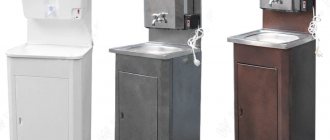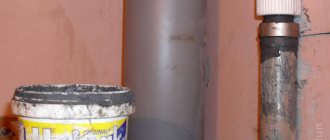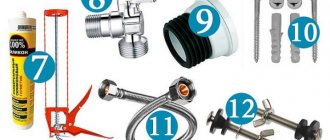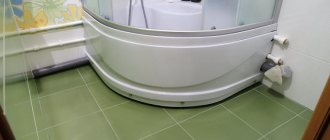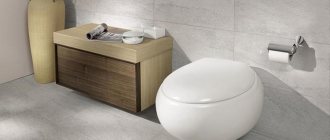Very often, various kinds of problems arise with bathtubs and sinks, or rather with draining water from them. There may be various reasons for stagnation, in which water will accumulate and cannot immediately drain into the pipe. Knowledgeable people may begin to look for the problem inside the pipes or try to remove the blockage, and if the cause was not found, they will certainly call a plumber. However, you should not rush to seek qualified help; perhaps the problem is much simpler, and it is quite easy to solve.
Features of cleaning the sink from blockages
Sewer clog in the sink A clog is formed as a result of small particles or specific liquids containing dissolved fats entering the drain.
The first ones, getting into the pipe, block the passage. The latter, deposited on the walls, gradually narrow the cross-section. The water leaves the sink more and more slowly. The result is complete blockage of the pipe. There are several ways to clear blockages:
- mechanical;
- washing;
- using chemicals.
In practice, if the kitchen sink is clogged, they start doing something with the simplest method at hand.
Causes of clogging
Before you start cleaning, you need to familiarize yourself with the main causes of blockages. These include the following:
- Mechanical. Most often, the sink becomes clogged due to mechanical blockages, during which foreign objects and debris get into the pipes. Gradually, the amount of debris accumulates, and water begins to flow worse through the pipes.
- Operational. Operational reasons include the accumulation of fat inside the pipes or the appearance of corrosion.
- Incorrect installation. Sometimes the kitchen is equipped with pipes that are installed incorrectly. Problems can arise if they are installed at the wrong angle, causing debris to gradually accumulate inside.
Removing clogs with soda
Regular soda can help you in the fight against operational blockages:
- Take a glass of soda and pour it into the drain hole;
- Now add a glass of vinegar there, which will enhance the effect of soda;
- Wait 15 minutes for the chemical reaction to complete;
- Pour a glass of hot boiling water, then open the tap and let the tap water run.
enhance the effect of soda by adding 5 tablespoons of washing powder or bleach to it. For a better effect, you can pour not boiling water into the drain hole, but fresh potato broth. It will help eliminate the unpleasant smell of sewerage.
You can also
use Alka-Seltzer anti-hangover tablets instead of soda. They are used in a similar way to baking soda and vinegar. Using tablets, you can remove a blockage in the pipe, and in addition to this, remove the unpleasant odor of sediment accumulated in the drain hole.
The above remedies are effective not only as a means to fight quarrels, but also to prevent their occurrence.
Call a plumber
Seeking help from a specialist may be recommended in the following cases:
- there is no time or desire to bother with cleaning the sewer;
- it was not possible to solve the problem on our own;
- the blockage affects the riser or its location could not be determined.
A plumber will help you deal with any kind of blockage. If replacement of worn parts and assemblies is required at the same time, the customer pays for them separately.
On average, the cost of eliminating a household blockage in the capital is from 700 rubles. Finding a company providing such services in your city on the Internet is not difficult.
Chemicals for cleaning sinks
To remove blockages in pipes in the kitchen, you can use not only soda and vinegar, but also a variety of chemicals that can be found in household chemical stores. Most often they are offered in three versions: liquid, powder or granular. Their main active component is an aggressive alkaline or acidic component.
To remove blockages in pipes using household chemicals, you need to do the following:
- Prepare a small amount of boiling water and pour it into the drain hole.
- Now add the cleaning agent there and wait two to three hours.
- Finally, pour a large amount of cold water over the suspected area of the clogged drain.
It is very effective to use chemicals to clean metal pipes, as they not only help clear blockages, but also remove rust from the walls.
be sure to follow safety rules when using chemicals Do not allow aggressive substances to come into contact with the skin or mucous membranes, otherwise this may lead to a chemical burn. To protect exposed areas of the body, use gloves and be careful not to splash the product too much.
Video description
How to remove dirt using a cable is shown in this video:
Cleaning with a hydraulic pump and soda
The hydraulic pump helps remove fresh dirt. Clearing a clogged sink is easy:
- First you need to soften the dirt plug. To do this, use a soda solution.
- Half a pack of soda is poured into the drain hole.
- Pour 1 cup of boiling water on top.
- The mass is left for 10 minutes. The time can be increased if cleaning has not been carried out for a long time.
- The hydraulic pump is filled with hot liquid and placed near the drain.
- Using the pressure of the pump, dirt deposits are pushed through and the pipe is cleared of debris.
If after the cleansing procedure the unpleasant odor has not disappeared, but the water still drains slowly, you can repeat the cleansing a second time. If this is not enough, you should pay attention to other cleaning methods.
Removing dirt using Sanfor
"Sanfor" is presented in the form of a gel product containing destructive and cleansing substances in the composition. The product not only pushes through debris deposits, but also prevents their reappearance.
If the sink is clogged, you need to take the following measures:
- View the instructions for use and take the gel product in the indicated dosage.
- Pour it into the drain hole and leave for 2 hours. During this time, a chemical reaction will occur, during which the pollution will begin to break down.
- Turn on the hot water and leave it for 10 minutes.
"Sanfor" is also used for preventive purposes. It is enough to clean the plumbing once every 2 months.
Removing garbage plugs using Tiret Turbo
Tiret Turbo is a popular means for cleaning plumbing fixtures, which is also used for preventive purposes. How to clean a sink with a chemical:
- Pour 200 ml of the chemical product into a plastic cup. If the contamination is old, you can increase the dose to 250 ml.
- Pour Tiret Turbo into the sink and leave for 1 hour.
- Rinse plumbing fixtures with hot water.
If the problem cannot be resolved at first, you can repeat the procedure. But no more than 2 times. Otherwise, the chemicals in the product may adversely affect the condition of the pipes.
Rinsing plumbing after chemical treatment
Deboucher for plumbing fixtures
This universal product removes both old and new stains. It contains chlorine, potassium and sodium. These substances dissolve debris plugs and protect the pipe surface from damage. The cleansing procedure is as follows:
- Pour 500 ml of product down the drain.
- Leave it for 1 hour.
- Turn on hot water for 10 minutes.
A significant drawback of the product is that it is not very economical to use. You will have to use up almost the entire contents of the tube in one go.
"Bagi Pothan" for removing blockages
Baghi Pothan is a product consisting of caustic soda and is used to clean sanitary ware. This product has a sharp and pungent odor and often leads to allergic reactions. Therefore, it is recommended to use gloves and a protective face mask during the cleaning process. The procedure looks like this:
- A few spoons of the powdered product are poured into the drain. This amount is sufficient to dissolve dense debris accumulations.
- Leave the sink for 1 hour.
- After this, rinse the drain with 1 liter of boiling water.
Bagi Pothan should be used no more than once every 3 months.
How to clean grease from kitchen pipes using soda and salt
A clog in the kitchen sink is often caused by an abundance of grease congealed in the pipes. In this case, ordinary salt and soda can solve the problem.
- Dissolve half a mug of salt and 1 mug of soda in a glass of water and pour the resulting mixture into the drain, wait 5-10 minutes.
- We use a plunger (or a rag) as described above (see method 2).
- We flush the pipes with a stream of hot water.
Why does the water in the sink drain slowly?
Water may begin to flow poorly in the sink due to several reasons, the main of which will be a clog. Pieces of food, residual fat, hair, and detergents accumulate in the siphon. Because of this, the diameter of the pipe becomes smaller and the liquid begins to flow poorly.
A blockage may also appear due to a small object getting into the pipe, for example, a toy, a lid from a jar, a paper clip, a piece of paper, and so on. In this case, the plug that prevents water from passing may not be in the siphon, but in some part of the pipe. Therefore, you can’t do without a plunger and a special cable.
REFERENCE! It is better to prevent blockages than to get rid of them. To do this, you need to regularly rinse the sink with boiling water, in a volume of about 2-3 liters. It is better to do this after each dishwashing or at least once a day.
You should also know that boiling water should only be poured into metal sinks; earthenware ones can burst if the water is too hot. In addition, you should be sure to use protective nets that will prevent particles of debris and food from entering the pipes.
How to clear clogged pipes with a plunger
- We tightly plug all overflow holes in the sink with a wet rag to block the passage of air and provide a hydraulic column.
- Press the plunger against the drain hole, then sharply pull it towards you. We repeat these steps several times to thoroughly “stir” the cork and break it into small pieces.
- We check the result by releasing a small stream of water.
- Let the hot water flow for a few minutes so that the plug goes down the drain safely.
Tips:
- If you don’t have a plunger at hand and the blockage is not too complicated, you can replace it with a glass or a rag. The steps are the same: press it against the drain and pull it out sharply.
- If you have a two-section sink, then you need to have two plungers and use them at the same time. That is, when cleaning the drain in one bowl of the sink, you need to close the drain in the second. This will create more suction force. If there is no second plunger, then close the second drain hole with a damp cloth and press it with your hand.
Baking soda, vinegar and lemon are useful for more than just lemon pie
Those who don’t like radical chemicals can always turn to homemade sink cleaning recipes. You can break through a cork using various substances that any housewife can find.
There is an opinion that keeping your apartment clean can be done by having a sponge, baking soda, lemon (citric acid) and vinegar on hand.
Mirrors and windows are rinsed with a vinegar solution; it has dust-repellent properties and does not leave streaks. Citric acid removes scale from teapots one-two-three times. Use baking soda to make your kitchenware shine. The list goes on for a long time. But let's turn to our problem - there is a blockage in the sink.
To remove a garbage plug, try any of the effective recipes below.
Soda and vinegar
Take 200 g of soda, pour it into the sink drain, add 250 ml of 9% vinegar, close the hole tightly. A rather caustic foam is formed, which will cope with the problem.
After half an hour, turn on the hot water, skip a few minutes to achieve perfect cleanliness of all elements of the sewer system. Cleaning should be done with the windows open.
Lemon acid
Take 100 g of citric acid, pour it into the sink drain, add a glass of boiling water, and close with a stopper. After half an hour, run hot water for a few minutes.
Alka-Seltzer
An original way to clean the sink siphon is to use a home first aid kit. Alka-Seltzer is perfect for solving our problem. Place 2-3 tablets in the drain, pour in 250 ml of 9% vinegar, close the drain hole. After a few minutes, run hot water.
In conclusion, let's talk about preventing a clogged kitchen sink, because many problems will not become so if we do not allow it ourselves.
Plumbing cable
The previous method is only suitable if the blockage is minor; it cannot cope with serious blockages. An option is a plumbing cable. It is suitable if:
- The blockage is deep in the pipe.
- The “plug” that closes the outflow of water is heavily compressed.
Plumbing cable is a dense wire in the shape of a spiral.
The essence of the method is to get rid of the blockage mechanically, pull it out or push it deeper into a wider pipe. The length of the standard cable is 3 meters, and this is quite enough to remove deep blockages.
The technique of using a cable is not complicated, but it must be strictly followed. Subsequence:
- the cable is inserted into the drain hole;
- one person pushes, the other rotates the cable. This helps break up the blockage and prevents the cable from breaking at the bends of the pipe;
- After the blockage has been cleared, you need to make a couple of jerks back and forth. After opening the hot water, you will wash away the dirt that has formed on the pipe;
- Now you can carefully pull out the cable.
This cleaning device can be purchased at any hardware store.
This device is used for severe blockages of metal pipes.
Note! It cannot be used for plastic and chrome-plated pipes; the cable design may damage their inner surface.
Clogged sewer pipe: reasons why there is a clog in the pipe
In most cases, we ourselves are to blame:
- When using the kitchen sink, we drain food residues, trimmings and dirt into it. In addition, during the dishwashing process, a lot of grease from the residue on the plates ends up in the drain. Gradually, fatty and limescale deposits are deposited inside. And the larger it is, the narrower the gap in the pipes, and as a result, a plug forms in it.
- In the bathroom, the problem is often caused by hair and animal fur that ends up in the drain after bathing.
- In the toilet, trouble can happen due to the ingress of certain hygiene products, cotton wool, paper, floor rags and other unwanted things that clog the pipe.
- In some cases, the cause of the trouble is improper installation of pipes (this happens especially often with modern plastic pipes) and violations during their installation - kinks, slopes. However, this shortcoming is revealed quite quickly after the start of operation, and it will not be possible to eliminate it on your own.
- In older houses, the cause of the blockage may be cast iron sewer pipes. Over time, corrosion appears on their inner walls, they become uneven with a strong coating of rust. In such places, and this is most often the section of pipe from the sink to the bathtub outlet, blockage is common.
- Lack of proper care and preventive cleaning of pipes.
Plug in the drain siphon - cross-sectional view.
If you notice that an unpleasant odor has appeared from the sink in the kitchen or in the bathtub, the rate of water flow through the drain has decreased, or the rise of water in the toilet bowl is often noticeable after flushing - it’s time to take action before the problem goes too far and you completely lose the ability to use them.
The reasons for the appearance of an unpleasant sewer smell in residential premises can be different, both internal and general.
The reasons for the appearance of an unpleasant sewer smell in residential premises can be different, both intra-apartment and general.
Vacuum cleaner
Some people do not want to use cleaning products and prefer to clear clogs with a regular vacuum cleaner. This method will help if the pipes are slightly clogged. A vacuum cleaner with an air blowing function is suitable for cleaning. Before blowing, carefully wrap the vacuum cleaner tube in a thick rag, after which it is installed in the drain hole. Then the device turns on the blowing mode to push through the blockage.
Prevention measures
To prevent blockages from recurring, preventive measures should be taken into account:
- Periodically you need to rinse the sink by running boiling water or hot water if the pipes are made of plastic;
- It is necessary to insert a special strainer into the kitchen sink drain, which will prevent large fragments of food waste from getting into the drain;
- You should not shake bread crumbs into the sink, wash off tea leaves, or pour out greasy liquid, as all this will stick to the pipes and accumulate in the siphon.
Steel tape
Long steel strips are used to break through clogs in the sink. They are strips of metal with peaks at the end. Thanks to this nozzle, it is possible to remove plugs from the pipeline.
How to break through a sink with steel tape:
- the sink is filled with water;
- a tape is placed in the drain;
- rotate around its axis several times;
- removed along with the dirt plug.
This device is suitable for breaking through blockages in sinks of any complexity. The belt is made of high carbon steel, which ensures a long service life.
What to do to prevent the sewer from getting clogged
You already know what not to throw down the drain, but there are also some other precautions. You need a mesh screen for your sink so that debris will not be able to get into the pipe. The cause of the blockage may be poor quality water that remains on the surface of the pipes. To avoid this, you need to install a water filter at home. Clean your pipes regularly. To do this, it is not necessary to use chemistry; you can use ordinary well-known folk methods.
Removing the clog... Alka-Seltzer
If there is suddenly no soda in the house, but there is Alka-Seltzer, then it can also clear a moderately clogged siphon. By the way, this product has another bonus - the unpleasant smell from the sink will disappear.
- Throw a couple of Alka-Seltzer tablets into the drain hole, and then pour in 1 cup of 9% vinegar.
- After 2 minutes, run the hot water full blast to help push through the dirt.
Preventive measures
Prevention measures are not complicated , but thanks to them, problems with water drainage will occur much less frequently:
- It is advisable to install a special sieve in the sink drain holes (both in the kitchen and in the bathroom). It will help prevent large particles and hair from entering the drain.
- You should regularly pour boiling water down the drain (for plastic pipes - just hot water). This will prevent sediment from accumulating on the surface of drainage communications.
- You should not clean food residues, construction mixtures, water after washing shoes, etc. into the sink.
Chemicals for cleaning sinks
Preparations for clearing blockages are available in the form of liquid, gel, powder or granules.
Chemicals for clearing clogs.
The principle of their use is the same:
- Liquid chemicals are poured into the sink opening and left for several minutes or hours.
- The granules are poured into the drain, a small amount of water is added and left for the time specified by the manufacturer.
- At the final stage, the pipeline is washed with plenty of running water.
Under the influence of alkaline and acidic compounds that are part of household chemicals, all types of organic matter dissolve:
- fatty deposits;
- lime deposits;
- leftover food;
- fruit and vegetable peels;
- hair.
Manufacturers place detailed instructions on the packaging of their products, which indicate the purpose, composition, method of use and safety measures.
Before starting work, you should carefully study this information and remember the following precautions:
- Do not shorten the exposure time of the drug, otherwise it will not have time to completely destroy the blockage.
- Do not use the product to clean plumbing fixtures and pipes for which it is not intended.
- When working with household chemicals, follow safety precautions and wear protective equipment - goggles, gloves, a respirator. If aggressive substances get on the skin, they can cause a burn; if they come into contact with the mucous membranes of the eyes, they can cause irritation and vision problems; if they inhale toxic fumes, they can cause poisoning and accompanying symptoms (nausea, vomiting, dizziness, headache, surges in blood pressure).
To combat blockages, buyers choose chemicals that, in most cases, are able to unclog the sink the first time:
| Release form | Names of household chemicals for removing blockages |
| Liquid | Mole |
| Gel-like | Mister Muscle, Sanox Clean stock, Deboucher active, Tiret turbo, Kloger Turbo |
| Granular | Anti-clogging, Bagi Pothan, Chirton Clean drains, Krotex, Mister Muscle, Mole, Floop |
However, chemicals are powerless against objects of inorganic origin that fall into a drain or sewer pipe.
Liquid cleaning agent Mole for sink blockages. Mister Muscle cleaning gel for clogs. Kloger Turbo is a gel-based cleaner for blockages. Granular cleaning product Mole
.
Gel-like cleaner for removing clogs. Bagi Pothan granular sink cleaner. Cleaning granular for blockages Chirton Clean drains
.
Tiret turbo gel-based sink cleaner
.
Deboucher active removes clogs from the sink.
When traditional methods don't help
Problem not solved? If first aid does not help, this means that the clog in the sink is old, large and dense. How to clear a blockage in a pipe if traditional recipes do not work? Don’t rush to call a plumber and disassemble the siphon; try using special chemicals (Mole, Tiret, Pothan, etc.) or a plumbing cable.
Method 7. How to clear a clogged pipe using a plumbing cable (and how to replace it at home)
If the kitchen sink is very clogged, you can use a special plumbing cable. This metal device looks like a brush with a long flexible handle (sold in hardware stores). Cleaning water pipes with a cable is best suited for metal structures - it can even partially remove rust. But the method is not suitable for cleaning plastic pipes, since there is a risk of damaging them due to excessive mechanical pressure.
- The cable is placed in the pipe and rotated. Here you can direct the movement both away from you, pushing the blockage into the sewer pipe, and towards you, pulling out the plug.
- When cleaning with a cable, you need to periodically supply water to the sink so that the flow of water washes away the released dirt.
- Run hot water for a few minutes to flush any remaining sediment down the drain.
Clue:
- If there is no cable on the household, then an ordinary metal hanger will come to the rescue, from which you can make a mini cable. Cut it with wire cutters so that the resulting wire has a small hook at the end (see picture below).
Method 8. How to clear a clog in the sink using household chemicals
Special products designed to remove blockages in pipes can be acidic or alkaline. Most often they are:
- Liquid and helium (for example, Sanfor, Tiret Turbo, Deboucher).
- Dry in the form of loose powder or granules (for example, Bagi Pothan, Mole, Chirton “Clean Drains”).
The pipe cleaner is selected depending on the material of the water pipe and the expected type of contamination.
Tips:
- The cheapest, well-known and universal remedy is “Mole”, which is based on acidic compounds and in most cases corrodes blockages of any origin. But for the most advanced cases, we recommend trying the fast-acting remedy Bagi Pothan in the form of granular powder.
- Liquid cleaners for clearing clogs are gentler and easier to use.
- Whatever remedy you choose, first clear the blockage with boiling water for 20 minutes (if the pipes are steel) or with a stream of hot water for 20 minutes (if the pipes are plastic). Then add the cleaning solution exactly following the manufacturer's instructions.
- If children live in the house, then it is better to buy a pipe cleaner for one time in small packages.
- Before you start cleaning your pipes, be sure to wear rubber gloves, otherwise the clog remover will attack not only the stopper, but also your skin.
- If you are planning to clear a clog in your sink using a caustic chemical or vinegar, be sure to open the window.
If none of the above methods work, then it is time to call a plumber. Most likely, the blockage has built up too deep and is packed tightly beyond the reach of most clog removal tools.
Dismantling the pipe and siphon
In some cases, the blockage can be removed without the use of folk remedies or aggressive chemicals. To improve water flow, it is enough to remove the siphon and clean it mechanically.
The classic siphon model has several details:
- a flask-shaped reservoir - acts as a water seal, preventing unpleasant odors from escaping from the sewer system;
- drain pipe - adjacent to the drain hole of the sink;
- outlet pipe - connects to a corrugation or waste pipe;
- nuts;
- sealing gaskets.
Most often, the problem is that a fatty coating forms inside the flask or on the walls of the pipes, which prevents the normal drainage of water. All parts of the plumbing fixture can be easily dismantled and assembled just as easily, so you can clean the siphon yourself.
Dismantling method:
- Put rubber gloves on your hands.
- If the space under the sink is poorly lit, prepare a flashlight.
- Remove all foreign objects from under the sink.
- Place a basin or bucket under the sink.
- Carefully unscrew the nut connecting the flask to the drain pipe.
- Disassemble the connection of the outlet pipe with the corrugation.
- Remove the siphon and clean it with any available object, such as a thin brush or an old toothbrush. Rinse with hot water.
- If the siphon is not clogged enough to impair the flow of wastewater, clean the drain with a plumbing cable.
- Reassemble the structure in reverse order.
- Check the tightness of the connections - place dry paper or cloth under the siphon and turn on the water. If no wet spots appear on the substrate during the day, then the assembly was carried out correctly. A leaking connection will have to be disassembled and reassembled, ensuring that the sealing gaskets are installed correctly.
The siphon can cause an unpleasant odor in the kitchen when the owners are away for a long time and do not use the sink. In such cases, the water in the flask completely evaporates and opens the way for foul-smelling gases from the sewer.
To solve this problem, just pour 1-1.5 liters of water into the sink. When leaving home for a long time, you need to pour a few drops of sunflower oil into the drain hole: the film floating on the surface of the water seal will not allow moisture to evaporate.
Video description
The effect of “Bagi Pothan” against plaque and pollution is clearly shown in this video clip:
"Mole" for blockages
"Mole" is a universal product for cleaning pipes. It contains potassium, sodium and acetic acid. This tandem removes heavy dirt and plaque. A significant advantage of the product is its low cost and effectiveness. In addition, it does not have an unpleasant odor and does not cause allergic reactions.
One application of "Mole" is enough for several months. To clean, pour a few spoons of the powdered product into the drain and leave it for 1 hour. After this, pour 1.5 liters of just boiled water into the pipe.
It's easier than ever to prevent blockages
It is enough to encounter a blockage once in order to strictly follow the rules for preventing such an unpleasant situation in the future. A strong sewer odor and the inability to use the sink effectively are all characteristics of a clog. How to avoid it?
Above, we have already convinced you of the need to purchase a drain mesh; this is a mandatory item in the program for preventing garbage plugs in the kitchen sink.
Let's talk about a food waste shredder, which can be purchased at construction supermarkets. This is certainly not the cheapest purchase, but it is completely worth every dollar invested.
Unfortunately, we are lazy and do not carefully clean the leftover food into the trash container. We make our work easier by simply rinsing the plates under running water before washing or loading them into the dishwasher.
After purchasing a shredder, you will forget the very word “clogging”, since now this indispensable assistant, working silently under the siphon, will deal with all waste quickly and efficiently.
If purchasing a household waste shredder is not in your immediate plans, let's talk about preventing blockages . It is enough to pay attention to the cleanliness of the kitchen sink drainage system once a week, and you will no longer have to deal with clearing garbage plugs in the drain.
So, every week make it a rule to pour several liters of boiling water into the drain for half an hour, then be sure to open the hot water tap. You can also use a plunger periodically to break up the deposits into small pieces.
Vegetable oil and other fats should not be drained into the drain hole of the sink; if, due to a misunderstanding, this does happen, the most correct action is to run hot water to clean the walls of the sewer elements from deposits. It will also be effective to use any home method for cleaning drains (see the exact recipes above in the article).
Thus, we see that we do not need any Herculean efforts to avoid clogging in the kitchen sink. Quite simple rules for caring for siphons and sewers will ensure uninterrupted and efficient operation of water supply and sanitation in your home.
If you couldn’t cope with the blockage on your own (using several different suggested methods), then it’s time to call a plumber. The cause of the problem can probably only be solved by professionals. Modern specialized equipment works wonders, so don’t despair, but start taking action.
We wish that only pleasant aromas settle in your home, trouble-free days reign, and the space is filled with that same indescribable atmosphere of comfort. Let your wonderful home help you start the day cheerfully and cheerfully, and end it in a relaxed atmosphere in a pleasant conversation with your family. Please accept our wishes for a great mood and well-being!
Siphon disassembly
The siphon under sinks is a dismountable device that can be cleaned by simply disconnecting it from the system. Despite the features of the models, the principle of organization of the devices is very similar. For the most part, cleaning is not difficult and can easily be done on your own, without the involvement of a plumber.
No complex tools or special skills are required for cleaning. The parts under the sink in plastic systems are fixed with plastic fasteners, which can be unscrewed simply by hand.
It must be taken into account that there is dirty water in the siphon. To prevent it from splashing, you should place a bucket or basin under the sink in advance.
When unwinding the siphon elements, it is necessary to monitor the condition of the gaskets. When they wear out, replacement will be required.
Clearing a clogged kitchen sink is shown step by step in the video:



